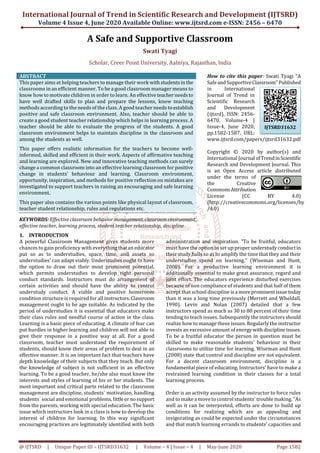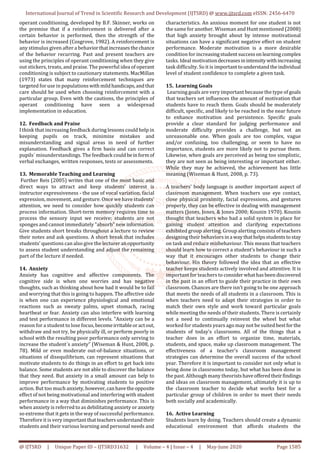This document summarizes strategies for effective classroom management. It discusses establishing clear expectations and rules, promoting positive teacher-student and peer relationships, handling mistakes in a supportive manner, and creating a safe and supportive classroom environment. The document emphasizes that classroom management requires motivating students, dealing effectively with behavioral issues, having high expectations, and maintaining a positive attitude as a role model.





![International Journal of Trend in Scientific Research and Development (IJTSRD) @ www.ijtsrd.com eISSN: 2456-6470
@ IJTSRD | Unique Paper ID – IJTSRD31632 | Volume – 4 | Issue – 4 | May-June 2020 Page 1587
Teachers do need knowledge to teach successfully in
different areas, for example: feedback and praise, handling
mistakes, questions from students, and clearly structured
lessons. Also to areas reducing anxiety, motivation, humor
and active time to learn are topics which are very important
for teachers. The praise is most effective when it is sincere
and natural. They should use appropriate gestures and
actions to accompany them. Teachers should try tomotivate
the students so that the students are more likely to pay
attention. To be respected with the children is also very
important. To react positively to wrong answers is a way to
teach positively. The relationship between students and
their parents is necessary. Students like when the teacher
uses their names. The classroom climate is so important. To
create a positive classroom climate is a main reason that the
children like to go into the school, and then childrenalsolike
to learn.
References
[1] Motivation for achievement: possibilities for teaching
and learning (2nd ed.). Mahwah, NJ: Lawrence
Erlbaum. Barnes, R. (199).
[2] Positive teaching, Positive learning: New York:
Routledge. Bulger, S. M., & Mohr, D., & Walls R. (2002).
[3] Stack the deck in favor of your students by using the
four aces of effective teaching. Journal of Effective
Teaching, 5(2). Ciaccio, J. (2004).
[4] Five factors for effective teaching. Hattie,J.A.C.(2012).
[5] Visible learning. A synthesis of over800meta-analyses
relating toachievement:London:Routledge.Helmke,A.
(2012).
[6] Principles of classroom management: a professional
decision-making model. New York: PearsonEducation.
Maples, F. (1992) :
[7] A counseling workshop for elementary school teacher:
ElementarySchool GuidanceandCounseling,27(1),33-
38. McAllister, L. S. (2012).
[8] Positive teaching : Strategies for optimal learning with
ADHD and hyperactive students. Merrett, F., &
Wheldall, K. (1990).
[9] Positive teaching in the primary school :Paul Chapman
Publishing. Muijs, D., & Reynolds, D. (2011).
[10] Effective teaching: Evidence and practice(3rdedition).
[11] Nonviolent communication: a language of life: create
your life, your relationships, and your world in
harmony with your values.KindleEditionSpinath,B.,&
Steinmayr, R. (2012).
[12] The Roles of competence, beliefs and goal orientations
for change in intrinsic motivation. Journal of
Educational Psychology, 104(4), 1135-1148.](https://image.slidesharecdn.com/300asafeandsupportiveclassroom-200723114502/85/A-Safe-and-Supportive-Classroom-6-320.jpg)